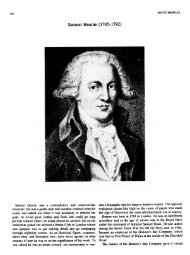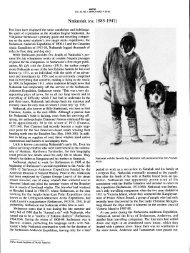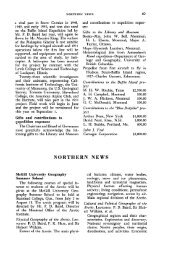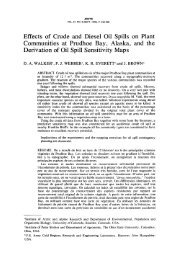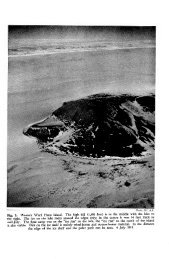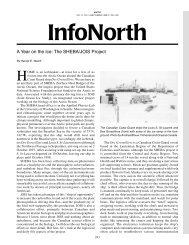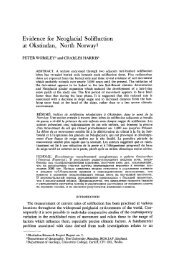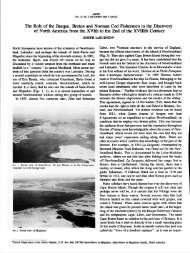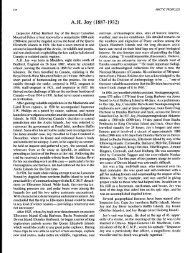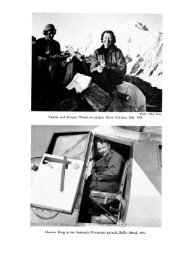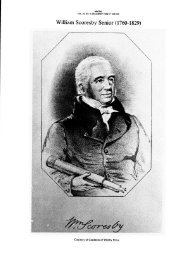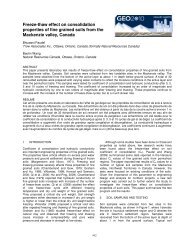Anvil Boulders and Lithic Reduction on Southern Victoria Island ...
Anvil Boulders and Lithic Reduction on Southern Victoria Island ...
Anvil Boulders and Lithic Reduction on Southern Victoria Island ...
You also want an ePaper? Increase the reach of your titles
YUMPU automatically turns print PDFs into web optimized ePapers that Google loves.
ARCTIC<br />
VOL. 45, NO. 2 (JUNE 1992) P. 138-144<br />
<str<strong>on</strong>g>Anvil</str<strong>on</strong>g> <str<strong>on</strong>g>Boulders</str<strong>on</strong>g> <str<strong>on</strong>g>and</str<strong>on</strong>g> <str<strong>on</strong>g>Lithic</str<strong>on</strong>g> <str<strong>on</strong>g>Reducti<strong>on</strong></str<strong>on</strong>g> <strong>on</strong> <strong>Southern</strong> <strong>Victoria</strong> Isl<str<strong>on</strong>g>and</str<strong>on</strong>g>, Northwest Territories<br />
JACK BRINK’<br />
(Received I I December 1990; accepted in revised form I5 August 1991)<br />
ABSTRACT. This paper reports <strong>on</strong> an unusual archaeological feature discovered at the Cadfael site (NiNg-17) <strong>on</strong> southeastern <strong>Victoria</strong> Isl<str<strong>on</strong>g>and</str<strong>on</strong>g>. TWO<br />
large boulders apparently served as anvil st<strong>on</strong>es <strong>on</strong> which quartzite cobbles were fractured. <str<strong>on</strong>g>Lithic</str<strong>on</strong>g> debris remained in situ <strong>on</strong> <str<strong>on</strong>g>and</str<strong>on</strong>g> around the boulders,<br />
preserving the materials <str<strong>on</strong>g>and</str<strong>on</strong>g> spatial arrangements as ab<str<strong>on</strong>g>and</str<strong>on</strong>g><strong>on</strong>ed by the last flintknappers. Analysis of <strong>on</strong>e boulder <str<strong>on</strong>g>and</str<strong>on</strong>g> the associated artifacts dem<strong>on</strong>strates<br />
that a bipolar technology was employed to split cobbles, presumably to obtain large flakes for use as, or for making into, tools. As far as is<br />
known, no similar features have been reported in the literature <strong>on</strong> the Canadian Arctic, although potential c<str<strong>on</strong>g>and</str<strong>on</strong>g>idates exist <strong>on</strong> Baffin Isl<str<strong>on</strong>g>and</str<strong>on</strong>g> <str<strong>on</strong>g>and</str<strong>on</strong>g> at<br />
Great Bear Lake. The age <str<strong>on</strong>g>and</str<strong>on</strong>g> cultural affiliati<strong>on</strong> of the Cadfael site anvil boulders are undetermined; however an associati<strong>on</strong> with the Late Dorset<br />
culture, dating to about lo00 years ago, seems most likely.<br />
Key words: arctic archaeology, lithic technology, Dorset culture, <strong>Victoria</strong> Isl<str<strong>on</strong>g>and</str<strong>on</strong>g><br />
RÉSUMÉ. Cette communicati<strong>on</strong> c<strong>on</strong>cerne la d6couverte d’un aménagement archéologique plutôt inhabituel trouvé au site Cadfael (NiNg-17), situé<br />
au sud de l’île <strong>Victoria</strong>. Deux grosses pierres y auraient apparemment servies d’enclumes où l’<strong>on</strong> aurait cassé des galets de quartzite. Les débris<br />
lithiques étaient restés in situ sur et autour des grosses roches, préservant ainsi le materiel et les arrangements spatiaux tels qu’ab<str<strong>on</strong>g>and</str<strong>on</strong>g><strong>on</strong>nés par les<br />
derniers artisans de la pierre. L’analyse d’une de ces grosses pierres et des artefacts qui y étaient associés, a dém<strong>on</strong>tré qu’une technique bipolaire fut<br />
utilisée pour fendre les galets afin d’obtenir de gros éclats utilisés comme d’outils ou dans la fabricati<strong>on</strong> de ces derniers. I1 semble que jusqu’ici<br />
aucun aménagement similaire n’a ét6 rapporté dans la littérature c<strong>on</strong>cernant l’arctique canadien, bien que des c<str<strong>on</strong>g>and</str<strong>on</strong>g>idats possibles existent sur la Terre<br />
de Baffin et au Gr<str<strong>on</strong>g>and</str<strong>on</strong>g> Lac de I’ Ours. Bien que I’âge et l’affiliati<strong>on</strong> culturelle des tnormes enclumes du site Cadfael soient indéterminés, une associati<strong>on</strong><br />
avec la période récente de la culture dorsétienne, soit il y a envir<strong>on</strong> lo00 ans avant le présent, est vraisemblable.<br />
Mots clés: archéologie de l’Arctique, technologie lithique, culture dorsétienne, île <strong>Victoria</strong><br />
INTRODUCTION<br />
Rec<strong>on</strong>naissance al<strong>on</strong>g porti<strong>on</strong>s of southeastern <strong>Victoria</strong> Isl<str<strong>on</strong>g>and</str<strong>on</strong>g>,<br />
Northwest Territories, during the summer of 1988 resulted in<br />
the recording of two unusual lithic features where reducti<strong>on</strong> of<br />
quartzite cobbles took place. The features discussed here are a<br />
small comp<strong>on</strong>ent of a large archaeological site known as the<br />
Cadfael site (NiNg-17), located <strong>on</strong> southern <strong>Victoria</strong> Isl<str<strong>on</strong>g>and</str<strong>on</strong>g>,<br />
50 km northwest of the community of Cambridge Bay (Fig. 1).<br />
The Cadfael site, first recorded by Taylor (1967), is situated<br />
<strong>on</strong> the northeastern side of Wellingt<strong>on</strong> Bay approximately<br />
1 km north of the mouth of the Ekalluk River. The Ekalluk is a<br />
short, fast, 3 km l<strong>on</strong>g river, which drains Fergus<strong>on</strong> Lake eastward<br />
into Wellingt<strong>on</strong> Bay. From the mouth of the river the<br />
coastline of Wellingt<strong>on</strong> Bay curves northward <str<strong>on</strong>g>and</str<strong>on</strong>g> is composed<br />
of a series of rocky beach ridges that trend roughly north to<br />
south. The site is located <strong>on</strong> <strong>on</strong>e of the lower beach ridges <str<strong>on</strong>g>and</str<strong>on</strong>g><br />
extends for almost 1 km in length. Most of the cultural features<br />
lie some 200-400 m east of the present waterline.<br />
When the Cadfael site was first discovered it was described<br />
as c<strong>on</strong>sisting of three large, heavy st<strong>on</strong>e, rectangular tent rings<br />
(Taylor, 1967:227). Test pitting yielded but a single artifact, a<br />
chert burin-like tool said to be typical of the Dorset culture<br />
(Taylor, 1967:227). Based <strong>on</strong> more in-depth scrutiny, the Cadfael<br />
site is now known to include at least three rectangular<br />
st<strong>on</strong>e structures (Taylor’s original rectangular tent rings, now<br />
comm<strong>on</strong>ly called “l<strong>on</strong>ghouses”), two outside row hearths,<br />
numerous cache structures, possible tent rings, as well as a<br />
nearby caribou drive lane system (“Inukshuit”).<br />
During the 1988 re-examinati<strong>on</strong> of the Cadfael site, Taylor<br />
observed two nearly identical localities where an intense<br />
amount of lithic workmanship had taken place. These lithic<br />
work stati<strong>on</strong>s, here termed “anvil boulders,” are unusual in<br />
that they preserve the artifacts <str<strong>on</strong>g>and</str<strong>on</strong>g> their spatial arrangements<br />
as they were ab<str<strong>on</strong>g>and</str<strong>on</strong>g><strong>on</strong>ed apparently about loo0 years ago. The<br />
anvil boulders are also of interest in that they do not appear to<br />
be reported elsewhere in the archaeological literature <strong>on</strong> the<br />
Canadian Arctic. The purpose of this article is to describe the<br />
anvil boulders, discuss their probable functi<strong>on</strong> <str<strong>on</strong>g>and</str<strong>on</strong>g> comment<br />
<strong>on</strong> their possible temporal <str<strong>on</strong>g>and</str<strong>on</strong>g> cultural affiliati<strong>on</strong>s.<br />
DESCRIPTION OF THE ANVIL BOULDER<br />
Time permitted careful study of <strong>on</strong>ly <strong>on</strong>e locality, referred<br />
to here as an anvil boulder. This c<strong>on</strong>sists of a large, flat-topped<br />
FIG. I. Map of southern <strong>Victoria</strong> Isl<str<strong>on</strong>g>and</str<strong>on</strong>g>,<br />
Cadfael site, NiNg-17.<br />
N.W.T., showing locati<strong>on</strong> of the<br />
‘Archaeological Survey, Provincial Museum of Alberta, 12845 - 102 Avenue, Edm<strong>on</strong>t<strong>on</strong>, Alberta, Canada T5N OM6<br />
@The Arctic Institute of North America
LITHIC TECHNOLOGY / 139<br />
boulder, believed to be granite, which lies partially buried in<br />
the beach ridge rocks. The boulder is roughly rectangular in<br />
outline, some 2 m l<strong>on</strong>g, 1.3 m wide <str<strong>on</strong>g>and</str<strong>on</strong>g> about 0.5 m high, with<br />
smooth, rounded corners <str<strong>on</strong>g>and</str<strong>on</strong>g> somewhat waisted in the middle<br />
(Fig. 2). At the time of inspecti<strong>on</strong> the top of the boulder was<br />
covered with a total of 33 quartzite cobbles <str<strong>on</strong>g>and</str<strong>on</strong>g> fragments<br />
thereof, dozens of small flakes, <str<strong>on</strong>g>and</str<strong>on</strong>g> 6 flat s<str<strong>on</strong>g>and</str<strong>on</strong>g>st<strong>on</strong>e slabs. The<br />
exposed porti<strong>on</strong>s of the boulder top, as well as the quartzite<br />
cobbles <str<strong>on</strong>g>and</str<strong>on</strong>g> flakes, were covered with a heavy coating of lichen<br />
<str<strong>on</strong>g>and</str<strong>on</strong>g>, between the cobbles, patches of moss, suggesting that the<br />
feature had been unmolested for a c<strong>on</strong>siderable period of time.<br />
Prior to study, the arrangement of rocks <strong>on</strong> top of the boulder<br />
was photographed <str<strong>on</strong>g>and</str<strong>on</strong>g> sketched (Figs. 2 <str<strong>on</strong>g>and</str<strong>on</strong>g> 3). Each of<br />
the quartzite cobbles <str<strong>on</strong>g>and</str<strong>on</strong>g> s<str<strong>on</strong>g>and</str<strong>on</strong>g>st<strong>on</strong>e slabs was then removed<br />
<str<strong>on</strong>g>and</str<strong>on</strong>g> examined, as was the surface of the boulder itself. All data<br />
were recorded at the site; no artifacts were collected, save a<br />
few small flakes for raw material analysis. The quick visit to<br />
the Cadfael site (<strong>on</strong>e half day) precluded quantificati<strong>on</strong> of<br />
many attributes that would have been desirable to record;<br />
however the basic properties of the lithic work stati<strong>on</strong>s were<br />
noted. The results of this investigati<strong>on</strong> are as follows.<br />
The 6 s<str<strong>on</strong>g>and</str<strong>on</strong>g>st<strong>on</strong>e slabs are pieces of the local beach ridge<br />
material that had been placed <strong>on</strong> the top of the boulder. The<br />
s<str<strong>on</strong>g>and</str<strong>on</strong>g>st<strong>on</strong>e pieces are relatively small <str<strong>on</strong>g>and</str<strong>on</strong>g> flat, ranging from 7<br />
to 15 cm in length. N<strong>on</strong>e shows signs of having been struck or<br />
having been used to deliver blows to other rocks, nor do they<br />
exhibit any signs of use. It will be noted (Fig. 3) that all the<br />
s<str<strong>on</strong>g>and</str<strong>on</strong>g>st<strong>on</strong>e pieces were situated at the two ends of the l<strong>on</strong>g axis<br />
of the boulder. The reas<strong>on</strong> for their inclusi<strong>on</strong> <strong>on</strong> top of the<br />
boulder is unknown; however the slabs may have served a role<br />
in the reducti<strong>on</strong> of the other lithics <strong>on</strong> the boulder, as discussed<br />
below.<br />
The 33 quartzite cobble specimens <strong>on</strong> the boulder top are,<br />
<strong>on</strong> average, about 15x10 cm in size. The largest specimen is a<br />
35 cm l<strong>on</strong>g by 26 cm wide boulder, <str<strong>on</strong>g>and</str<strong>on</strong>g> the smallest are cobbles<br />
with lengths of 8-10 cm. In c<strong>on</strong>trast to the s<str<strong>on</strong>g>and</str<strong>on</strong>g>st<strong>on</strong>e<br />
slabs, all but 2 of the 33 quartzite cobbles exhibit evidence of<br />
cultural modificati<strong>on</strong>, including impact marks, fractures, or<br />
both (Fig. 4). The two unmodified specimens were both relatively<br />
small quartzite pebbles with a maximum dimensi<strong>on</strong> of<br />
about 10 cm. The raw material of all the cobbles <str<strong>on</strong>g>and</str<strong>on</strong>g> spalls is<br />
a fine-grained quartzite. The great majority of the quartzite is<br />
grey to beige in colour, with a few specimens exhibiting a distinct<br />
pinkish hue (this appears to be the natural colour of the<br />
rock <str<strong>on</strong>g>and</str<strong>on</strong>g> not a result of intenti<strong>on</strong>al heat treatment). In general,<br />
the quality of the material is quite good, with thin secti<strong>on</strong> analysis<br />
of <strong>on</strong>e specimen showing a tight interlocking of recrystallized<br />
quartz grains producing a smooth <str<strong>on</strong>g>and</str<strong>on</strong>g> durable surface<br />
(D. Sharpe, pers. comm. 1990).<br />
Of the 3 1 modified quartzite specimens, all but 4 were fractured.<br />
One of the unfractured pieces was the large, 35 cm l<strong>on</strong>g<br />
@ Impacted or fractured quartzite<br />
0 Unmodified quartzite<br />
Unmodified s<str<strong>on</strong>g>and</str<strong>on</strong>g>st<strong>on</strong>e<br />
30 CM<br />
FE. 2. First anvil boulder at Cadfael site prior to removal <str<strong>on</strong>g>and</str<strong>on</strong>g> study of quartzite<br />
<str<strong>on</strong>g>and</str<strong>on</strong>g> s<str<strong>on</strong>g>and</str<strong>on</strong>g>st<strong>on</strong>e rocks.<br />
FIG. 3. Sketch of first anvil boulder showing distributi<strong>on</strong> of modified<br />
quartzite <str<strong>on</strong>g>and</str<strong>on</strong>g> unmodified quartzite <str<strong>on</strong>g>and</str<strong>on</strong>g> s<str<strong>on</strong>g>and</str<strong>on</strong>g>st<strong>on</strong>e.
140 I J. BRINK<br />
RG. 4. Specimen of battered <str<strong>on</strong>g>and</str<strong>on</strong>g> fractured quartzite from of top fiist anvil boulder.<br />
cobble, which exhibited extensive peck marks in the centre of<br />
<strong>on</strong>e surface. These marks may have been produced by the use<br />
of this rock as a hammerst<strong>on</strong>e to break other cobbles, by use<br />
of the surface of the large cobble as an anvil <strong>on</strong> which smaller<br />
cobbles were broken, or through unsuccessful attempts to<br />
break this cobble. The other 3 unfractured specimens are all<br />
mid-sized cobbles, approximately 15 cm l<strong>on</strong>g, which exhibit<br />
surface peck marks indicative of repeated battering. Two of<br />
the rocks show fracture lines that failed to propagate.<br />
The remaining 27 specimens are all fractured quartzite cobbles.<br />
For these artifacts the following informati<strong>on</strong> was<br />
recorded: 1) the number of fractures <strong>on</strong> each specimen, as<br />
deduced from counts of flake facets <str<strong>on</strong>g>and</str<strong>on</strong>g> impact points; 2) the<br />
number of additi<strong>on</strong>al impact marks that did not propagate fractures,<br />
as deduced from batter or impact marks; 3) the orientati<strong>on</strong><br />
of the fractures - that is, whether the fractures originated<br />
from the ends of the l<strong>on</strong>g axis (l<strong>on</strong>gitudinal), or whether they<br />
were initiated from the sides of the cobbles (transverse).<br />
Finally, a subjective assessment of the quality of st<strong>on</strong>e was<br />
made, ranking the perceived flaking properties based <strong>on</strong> grain<br />
size <str<strong>on</strong>g>and</str<strong>on</strong>g> degree of cementati<strong>on</strong>. In this crude assessment, artifacts<br />
were ranked <strong>on</strong> a scale of 1 to 3, with 1 being the best<br />
<str<strong>on</strong>g>and</str<strong>on</strong>g> 3 being the poorest quality.<br />
As seen in Table 1, l<strong>on</strong>gitudinal fractures, initiated from the<br />
ends of the l<strong>on</strong>g axes of the cobble, were preferred for splitting<br />
the quartzite cobbles. Sixteen (nearly 60%) of the specimens<br />
were broken <strong>on</strong>ly in this manner. In all cases impact<br />
marks were evident <strong>on</strong> the opposing ends of the l<strong>on</strong>g axes.<br />
Most of the remaining artifacts (33%) show evidence of both<br />
l<strong>on</strong>gitudinal <str<strong>on</strong>g>and</str<strong>on</strong>g> transverse fracturing. For these specimens<br />
evidence of battering <str<strong>on</strong>g>and</str<strong>on</strong>g> crushing from impact was evident<br />
<strong>on</strong> opposing ends as well as at the centre of the sides of the<br />
cobbles. Only two specimens were broken exclusively in<br />
transverse secti<strong>on</strong> (impact marks <strong>on</strong> the sides of the cobbles<br />
but absent from the opposing ends).<br />
Most of the specimens (70%) exhibited either <strong>on</strong>e or two<br />
fractures (10 <str<strong>on</strong>g>and</str<strong>on</strong>g> 9 specimens respectively). One artifact was<br />
fractured five times, <str<strong>on</strong>g>and</str<strong>on</strong>g> the remaining 7 items were fractured<br />
either three or four times. All the cobbles exhibited impact<br />
marks in additi<strong>on</strong> to the blow that had actually fractured the<br />
cobble. Most cobbles (15) showed evidence of having been<br />
struck <strong>on</strong>ce in additi<strong>on</strong> to the completed fracture, while the<br />
remainder exhibited either two (7), three (4) or four (1) impact<br />
marks. In all cases, the cortex of the cobbles, at the various<br />
points of impact, was characterized by signs of crushing <str<strong>on</strong>g>and</str<strong>on</strong>g><br />
battering.<br />
To look for a correlati<strong>on</strong> between quality of material <str<strong>on</strong>g>and</str<strong>on</strong>g> the<br />
frequency of fractures <str<strong>on</strong>g>and</str<strong>on</strong>g> blows delivered to the specimens,<br />
the mean for each of the above variables was calculated for<br />
each of the three rankings of rock quality (Table 2). As might<br />
be expected, the mean number of times a cobble had been<br />
fractured increased as the quality of the material improved.<br />
However, higher quality materials did not necessarily result in<br />
more blows delivered to the specimen. Presumably, the better<br />
quality materials fractured more readily when struck, leaving<br />
fewer failed impact marks.<br />
In additi<strong>on</strong> to the cobble cores, the top of the boulder was<br />
also littered with about three dozen small quartzite flakes <str<strong>on</strong>g>and</str<strong>on</strong>g><br />
pieces of shatter. A brief attempt at refitting proved that <strong>on</strong>e<br />
step-fractured flake joined with a nearby core <str<strong>on</strong>g>and</str<strong>on</strong>g> two cortical<br />
flakes fit together, though not <strong>on</strong>to any of the cores. The presence<br />
of refitted material suggests that lithic reducti<strong>on</strong> was c<strong>on</strong>ducted<br />
<strong>on</strong> the top of the boulder rather than already fractured<br />
cobbles having been placed there. If cobble reducti<strong>on</strong> took place<br />
<strong>on</strong> the boulder, it would be expected that the ground surface<br />
around the periphery of the rock would yield additi<strong>on</strong>al lithic<br />
material. The ground cover of moss was pulled away to reveal<br />
TABLE 1. Attributes of quartzite cobbles from the surface of the<br />
anvil boulder at NiNg-17, Cadfael site, <strong>Victoria</strong> Isl<str<strong>on</strong>g>and</str<strong>on</strong>g> (X=present)<br />
Cobble Fracture type No. of No. additi<strong>on</strong>al<br />
number L<strong>on</strong>g. Trans. L<strong>on</strong>g.+trans. fractures impacts Quality<br />
1<br />
2<br />
3<br />
4<br />
5<br />
6<br />
7<br />
8<br />
9<br />
10<br />
11<br />
12<br />
13<br />
14<br />
15<br />
16<br />
17<br />
18<br />
19<br />
20<br />
21<br />
22<br />
23<br />
24<br />
25<br />
26<br />
27<br />
X<br />
X<br />
X<br />
X<br />
X<br />
X<br />
X<br />
X<br />
X<br />
X<br />
X<br />
X<br />
X<br />
X<br />
X<br />
X<br />
X<br />
X<br />
X<br />
X<br />
X<br />
X<br />
X<br />
X<br />
X<br />
X<br />
X<br />
Total 16(59.3%) 2(7.4%) 9(33.3%) X=2.07 X=1.67 X=2.07<br />
TABLE 2. Comparis<strong>on</strong> of number of impacts <str<strong>on</strong>g>and</str<strong>on</strong>g> fractures in three subjective<br />
categories of quartzite quality, NiNg-17<br />
Quality type Mean no. fractures Mean no.<br />
1 (best) 2.60 1.40<br />
2 2.13<br />
3 (poorest) 1.57 1.14<br />
5<br />
2<br />
1<br />
2<br />
2<br />
2<br />
2<br />
2<br />
3<br />
2<br />
3<br />
2<br />
3<br />
3<br />
1<br />
1<br />
1<br />
1<br />
4<br />
4<br />
1<br />
1<br />
1<br />
2<br />
1<br />
3<br />
1<br />
3<br />
1<br />
1<br />
2<br />
1<br />
1<br />
2<br />
2<br />
1<br />
1<br />
3<br />
2<br />
3<br />
1<br />
1<br />
1<br />
1<br />
2<br />
1<br />
4<br />
2<br />
1<br />
1<br />
2<br />
1<br />
3<br />
1<br />
1<br />
1<br />
2<br />
2<br />
2<br />
1<br />
3<br />
2<br />
2<br />
2<br />
2<br />
2<br />
2<br />
1<br />
3<br />
3<br />
2<br />
2<br />
3<br />
2<br />
2<br />
1<br />
3<br />
2<br />
3<br />
2<br />
3
LITHIC TECHNOLOGY / 141<br />
a mass of flaking remains mixed in with the natural beach<br />
ridge rock. Dozens, if not hundreds (no exact count was made),<br />
of split cobbles <str<strong>on</strong>g>and</str<strong>on</strong>g> large flakes were observed within a few<br />
metres of the edge of the boulder.<br />
If, as suspected, the large boulder had served as a work stati<strong>on</strong><br />
for the reducti<strong>on</strong> of quartzite cobbles, it would be reas<strong>on</strong>able<br />
to suspect that there would be evidence of this functi<strong>on</strong><br />
<strong>on</strong> the boulder itself. With this in mind, the boulder top was<br />
swept clean of all moss <str<strong>on</strong>g>and</str<strong>on</strong>g> flaking debris. Once exposed it<br />
was apparent that the central regi<strong>on</strong> of the boulder had indeed<br />
been modified. At the very centre of the boulder top was a circular<br />
cavity about 1 cm deep, 5 cm in diameter, with flared<br />
edges (Fig. 5). It is tempting to suggest that the cavity was<br />
intenti<strong>on</strong>ally pecked to help stabilize cobbles during the reducti<strong>on</strong><br />
process. It is equally possible, however, that the depressi<strong>on</strong><br />
was simply produced through c<strong>on</strong>tinuous use of the same<br />
spot <strong>on</strong> the boulder. Whatever the case, there seems little<br />
doubt that this space served as a place to anchor <str<strong>on</strong>g>and</str<strong>on</strong>g> stabilize<br />
the cobbles during fracturing. Other rocks, including perhaps<br />
the s<str<strong>on</strong>g>and</str<strong>on</strong>g>st<strong>on</strong>e slabs noted above, may have been placed<br />
against the sides of the cobbles to hold them upright during<br />
fracturing.<br />
ANVIL BOULDER TECHNOLOGY<br />
Data collected during this study str<strong>on</strong>gly suggest that the<br />
large boulder served as a giant anvil <strong>on</strong> which the reducti<strong>on</strong> of<br />
quartzite cobbles took place. Cobbles were placed in the centre<br />
of the boulder, planted firmly in a cavity in the rock, which<br />
may have been specially prepared for this purpose, perhaps<br />
supported around the edges with additi<strong>on</strong>al rocks, <str<strong>on</strong>g>and</str<strong>on</strong>g> struck<br />
with a hammerst<strong>on</strong>e. Hammerst<strong>on</strong>es may have been dropped<br />
or thrown from above or, for fracturing the smaller specimens,<br />
h<str<strong>on</strong>g>and</str<strong>on</strong>g> held. As a result of this vigorous activity, a dense scatter<br />
of lithic remains covers an area of many metres around the<br />
base of the boulder.<br />
The reducti<strong>on</strong> method employed at the Cadfael anvil boulder<br />
was essentially a bipolar technology. Used by many st<strong>on</strong>eworking<br />
cultures (see Hayden, 1980, <str<strong>on</strong>g>and</str<strong>on</strong>g> Le Blanc, 1984:<br />
183-184, for a review), the essence of the technique involves<br />
placement of a target st<strong>on</strong>e <strong>on</strong> an anvil <str<strong>on</strong>g>and</str<strong>on</strong>g> delivering a blow<br />
with an impactor (Binford <str<strong>on</strong>g>and</str<strong>on</strong>g> Quimby, 1963; Forsman, 1976;<br />
MacD<strong>on</strong>ald, 1968; Le Blanc, 1984:183). As force is applied to<br />
FIG. 5. Pecked cavity in centre of first anvil boulder, believed to have been used<br />
to “seat” the cobbles prior to reducti<strong>on</strong>.<br />
<strong>on</strong>e end of the target with the hammerst<strong>on</strong>e, it is likewise<br />
returned from c<strong>on</strong>tact between the anvil <str<strong>on</strong>g>and</str<strong>on</strong>g> the other end of<br />
the target. This produces a series of characteristic attributes<br />
that may be observed <strong>on</strong> the core, the detached flakes, or both.<br />
Most’important are the presence of two points of impact (platforms)<br />
located at opposite ends from each other, evidence of<br />
battering <str<strong>on</strong>g>and</str<strong>on</strong>g> crushing <strong>on</strong> the striking platforms, <str<strong>on</strong>g>and</str<strong>on</strong>g> flakes<br />
that typically extend the full length of the core (Binford <str<strong>on</strong>g>and</str<strong>on</strong>g><br />
Quimby, 1963; Forsman, 1976; Hayden, 1980). As Hayden<br />
(1980:4) notes, bipolar technology typically produces large<br />
amounts of broken, relatively useless chunks of material, as<br />
was the case at Cadfael. Hayden (1980:4) also states that use<br />
of the bipolar technique often results in the producti<strong>on</strong> of pits<br />
<strong>on</strong> the surface of the anvil where the target was struck. This is<br />
c<strong>on</strong>sistent with the pitting observed <strong>on</strong> the Cadfael anvil boulder.<br />
C<strong>on</strong>sidering all the features observed <strong>on</strong> the Cadfael<br />
quartzite specimens <str<strong>on</strong>g>and</str<strong>on</strong>g> <strong>on</strong> the anvil top, there seems little<br />
doubt that the cobbles were reduced by means of the bipolar<br />
technique.<br />
As the Cadfael site has not been excavated, it is difficult to<br />
know the desired end product of the lithic activity. The presence<br />
of numerous split cobbles <str<strong>on</strong>g>and</str<strong>on</strong>g> large spalls ab<str<strong>on</strong>g>and</str<strong>on</strong>g><strong>on</strong>ed <strong>on</strong><br />
<str<strong>on</strong>g>and</str<strong>on</strong>g> around the anvil st<strong>on</strong>e suggests that <strong>on</strong>e functi<strong>on</strong> of this<br />
workshop was to test the quality of various cobbles in search<br />
of prime flaking material. Once this was achieved, the flake<br />
spalls may have been used as is or further reduced into more<br />
finely crafted tools. No formed tools were recovered near the<br />
anvil boulder, <str<strong>on</strong>g>and</str<strong>on</strong>g> there was no evidence that further reducti<strong>on</strong><br />
of the split cobbles into finer forms occurred at this locale.<br />
Certainly, large quartzite spalls could have been used as multipurpose<br />
tools with little or no further modificati<strong>on</strong>. But it is<br />
equally possible that spalls were removed from the boulder<br />
<str<strong>on</strong>g>and</str<strong>on</strong>g> fashi<strong>on</strong>ed into formed tools.<br />
The few lithic tools recovered from surface inspecti<strong>on</strong> <str<strong>on</strong>g>and</str<strong>on</strong>g><br />
test pitting at the Cadfael site were made of high quality,<br />
locally available chert (Taylor, 1967, 1972). Relatively coarse<br />
st<strong>on</strong>e such as quartzite could indeed be fashi<strong>on</strong>ed into fine<br />
tools, as is noted, for example, at the Lago<strong>on</strong> site <strong>on</strong> Banks<br />
Isl<str<strong>on</strong>g>and</str<strong>on</strong>g> (Arnold, 1980). Research by Taylor in the Ekalluk<br />
regi<strong>on</strong> suggests that readily available cherts were employed<br />
for the most delicate tool types <str<strong>on</strong>g>and</str<strong>on</strong>g> quartzites were used in the<br />
manufacture of larger, coarser tools. Thus, it seems most reas<strong>on</strong>able<br />
to posit that the producti<strong>on</strong> of large quartzite flakes,<br />
perhaps to be used as multi-purpose tools, may have been the<br />
desired end product of the lithic activity carried out at the anvil.<br />
While time permitted a detailed study of <strong>on</strong>ly <strong>on</strong>e anvil<br />
boulder, a sec<strong>on</strong>d nearly identical feature was noted at the<br />
Cadfael site. Located some 100 m north of the first boulder<br />
was a sec<strong>on</strong>d large, flat-topped rock, the surface of which was<br />
littered with quartzite cobbles <str<strong>on</strong>g>and</str<strong>on</strong>g> a few pebbles (Fig. 6). A<br />
quick inspecti<strong>on</strong> revealed that these cobbles had also been battered<br />
<str<strong>on</strong>g>and</str<strong>on</strong>g> split, most likely with the boulder top again serving<br />
as the anvil platform. The ground surface surrounding the<br />
boulder was also covered with ab<str<strong>on</strong>g>and</str<strong>on</strong>g><strong>on</strong>ed cores <str<strong>on</strong>g>and</str<strong>on</strong>g> flaking<br />
debris. In order to allow for future study, under less time<br />
restricti<strong>on</strong>, n<strong>on</strong>e of the material <strong>on</strong> or around the sec<strong>on</strong>d anvil<br />
was collected or disturbed.<br />
As to the origin of the quartzite cobbles reduced at these<br />
features, from the geological literature for this regi<strong>on</strong> it is clear<br />
that s<str<strong>on</strong>g>and</str<strong>on</strong>g>st<strong>on</strong>e makes up the primary comp<strong>on</strong>ent of the extensive<br />
beach ridges of the east side of Wellingt<strong>on</strong> Bay<br />
(Thorsteinss<strong>on</strong> <str<strong>on</strong>g>and</str<strong>on</strong>g> Tozer, 1962). Mixed with these s<str<strong>on</strong>g>and</str<strong>on</strong>g>st<strong>on</strong>es<br />
is a quartz-pebble c<strong>on</strong>glomerate that is exposed al<strong>on</strong>g the
142 / J. BRINK<br />
FIG. 6. The sec<strong>on</strong>d anvil boulder, as found, at the Cadfael site.<br />
south coast of <strong>Victoria</strong> Isl<str<strong>on</strong>g>and</str<strong>on</strong>g> <str<strong>on</strong>g>and</str<strong>on</strong>g> probably <strong>on</strong> the east side of<br />
Wellingt<strong>on</strong> Bay. Rounded cobbles of quartzite would occur<br />
within this quartz-pebble c<strong>on</strong>glomerate, making this the likely<br />
source of the cobbles used at the Cadfael site (D. Sharpe, pers.<br />
comm. 1990). In additi<strong>on</strong>, a plentiful supply of quartzite pebbles<br />
<str<strong>on</strong>g>and</str<strong>on</strong>g> cobbles would have been available in the valley of<br />
the Ekalluk River to the south of the site. Thus, the lithic<br />
materials are essentially local <str<strong>on</strong>g>and</str<strong>on</strong>g> would probably be found in<br />
large numbers in the immediate vicinity of the site.<br />
TEMPORAL AND CULTURAL CONSIDERATIONS<br />
Assessing the age <str<strong>on</strong>g>and</str<strong>on</strong>g> cultural affiliati<strong>on</strong> of the anvil boulders<br />
poses c<strong>on</strong>siderable difficulties. Aside from the lichen <str<strong>on</strong>g>and</str<strong>on</strong>g><br />
moss cover, which argues for a l<strong>on</strong>g period of neglect, the<br />
appearance of the two boulders is as if the lithic craftspers<strong>on</strong><br />
had recently walked away. The use of the anvils could be of any<br />
age or of several ages. Although the anvils themselves cannot<br />
be dated, examinati<strong>on</strong> of other aspects of both the Cadfael site<br />
<str<strong>on</strong>g>and</str<strong>on</strong>g> of the archaeology of the regi<strong>on</strong> may shed light <strong>on</strong> the age<br />
<str<strong>on</strong>g>and</str<strong>on</strong>g> cultural affiliati<strong>on</strong> of the anvil boulders.<br />
The presence of l<strong>on</strong>ghouses - rectangular boulder arrangements<br />
- at the Cadfael site, especially those associated with<br />
outside row hearths, is c<strong>on</strong>sidered to be indicative of Late<br />
Dorset occupati<strong>on</strong> (Maxwell, 1985: 157; McGhee, 1978:68-69;<br />
Schledermann, 1990:330). One excavated l<strong>on</strong>ghouse <strong>on</strong> the<br />
Knud Peninsula, Ellesmere Isl<str<strong>on</strong>g>and</str<strong>on</strong>g>, produced “a fine assemblage<br />
of Late Dorset artifacts,” although some mixing of earlier<br />
elements was apparent (Schledermann, 1990:216). At the<br />
same site a series of radiocarb<strong>on</strong> dates were obtained from the<br />
nearby row hearths yielding an average age of about 1100<br />
B.P., or A.D. 800 (Schledennann, 1990:229-230). Excavated<br />
l<strong>on</strong>ghouses in Ungava have been assigned an approximate age<br />
of about A.D. 1000 (Plumet, 1982:262; 1985:355). Damkjar<br />
(1990) reviews radiocarb<strong>on</strong> dates for l<strong>on</strong>ghouse sites, dismisses<br />
many questi<strong>on</strong>able dates, <str<strong>on</strong>g>and</str<strong>on</strong>g> c<strong>on</strong>cludes that well-dated<br />
l<strong>on</strong>ghouse structures cluster between 1100 <str<strong>on</strong>g>and</str<strong>on</strong>g> 1200 B.P.<br />
Although there is some evidence for roots in the Middle<br />
Dorset period (Damkjar, 1990), there seems to be a c<strong>on</strong>sensus<br />
that these distinctive structures are primarily a phenomen<strong>on</strong> of<br />
the Late Dorset period (Damkjar, 1990; Schledermann,<br />
1990:330).<br />
Test pits excavated at the Cadfael site support the associati<strong>on</strong><br />
between l<strong>on</strong>ghouses <str<strong>on</strong>g>and</str<strong>on</strong>g> the Late Dorset culture. A single<br />
harpo<strong>on</strong> head was recovered <str<strong>on</strong>g>and</str<strong>on</strong>g> identified as typical of Late<br />
Dorset styles (J. Helmer, pers. comm. 1989). In additi<strong>on</strong>, a<br />
radiocarb<strong>on</strong> date was obtained from a sample of b<strong>on</strong>e collected<br />
from a test pit located outside <strong>on</strong>e of the rectangular<br />
house structures. The date of 1080+125 (S-3039) B.P. is in<br />
agreement with the postulated Late Dorset occupati<strong>on</strong>. Finally,<br />
no artifacts or structural features were noted that are associated<br />
with any other cultural or temporal period.<br />
Thus, at least some comp<strong>on</strong>ents of the Cadfael site can be<br />
securely assigned to the Late Dorset period dating to about<br />
1000 years ago. As there is no necessary associati<strong>on</strong> between<br />
the quartzite work stati<strong>on</strong>s <str<strong>on</strong>g>and</str<strong>on</strong>g> other cultural structures at the<br />
Cadfael site, other than spatial proximity, it cannot be assumed<br />
that the use of the anvil boulders also dates exclusively to the<br />
Late Dorset period. Cultural affiliati<strong>on</strong> of the features can be<br />
addressed, however, through ancillary lines of evidence that<br />
c<strong>on</strong>cern the regi<strong>on</strong>al prehistory.<br />
Other sites in the Ekalluk River, Wellingt<strong>on</strong> Bay, Fergus<strong>on</strong><br />
Lake regi<strong>on</strong> have been partially excavated <str<strong>on</strong>g>and</str<strong>on</strong>g> provide a basis<br />
for comparis<strong>on</strong>. Looking first at other sites known or c<strong>on</strong>sidered<br />
to be of Late Dorset age, we might expect that sites of<br />
similar age in close proximity would exhibit evidence of some<br />
of the quartzite from the Cadfael site, or perhaps of a similar<br />
type of lithic reducti<strong>on</strong> industry. Taylor (1967:225) reports<br />
that Late Dorset occupati<strong>on</strong>s within the Ekalluk regi<strong>on</strong> are<br />
generally rare. However, within a radius of a few kilometres<br />
of Cadfael, evidence of Late Dorset occupati<strong>on</strong> at three sites<br />
has been noted: the Bell site (NiNg-2), located at the outlet of<br />
Fergus<strong>on</strong> Lake <strong>on</strong> the south bank of the Ekalluk River; NiNg-<br />
8, located <strong>on</strong> a small knoll overlooking the mouth of the<br />
Ekalluk River at Wellingt<strong>on</strong> Bay; <str<strong>on</strong>g>and</str<strong>on</strong>g> a single harpo<strong>on</strong> head<br />
surface collected from the otherwise predominantly Pre-<br />
Dorset site of Buchanan <strong>on</strong> the south bank of the Ekalluk<br />
River (Taylor, 1964, 1967, 1972).<br />
Dismissing the latter isolated find, <strong>on</strong>e of the remaining<br />
two Late Dorset sites, the Bell site, c<strong>on</strong>tains quartzite artifacts.<br />
Though not menti<strong>on</strong>ed in the publicati<strong>on</strong> (Taylor, 1967),<br />
inspecti<strong>on</strong> of the collecti<strong>on</strong>s reveals that grey quartzites present<br />
at the Bell site are generally similar in colour <str<strong>on</strong>g>and</str<strong>on</strong>g> texture<br />
to materials observed at the Cadfael anvil boulders. Also collected<br />
from the Bell site were several fractured quartzite pebbles,<br />
two of which exhibit evidence of use as hammerst<strong>on</strong>es.<br />
The colour <str<strong>on</strong>g>and</str<strong>on</strong>g> texture of <strong>on</strong>e of these pebbles is again similar<br />
to the items observed at Cadfael. Thus, there appears to be evidence<br />
for the use of quartzite at the Bell site located some 2<br />
km southeast of the Cadfael site. Worth noting, however, is<br />
the fact that the Bell site yielded artifacts of both early <str<strong>on</strong>g>and</str<strong>on</strong>g> late<br />
Dorset as well as Thule material, <str<strong>on</strong>g>and</str<strong>on</strong>g> not always in proper<br />
stratigraphic relati<strong>on</strong>ship (Taylor, 1967:223). The cultural<br />
affiliati<strong>on</strong> of the quartzite artifacts from the Bell site remains,<br />
therefore, suggestive but inc<strong>on</strong>clusive.<br />
Within the same geographic regi<strong>on</strong> quartzite is known to be<br />
comm<strong>on</strong> to, <str<strong>on</strong>g>and</str<strong>on</strong>g> perhaps indicative of, a number of Pre-Dorset<br />
sites. Arnold (1980:412) notes that the dependence <strong>on</strong> quartzite<br />
al<strong>on</strong>g the Ekalluk River is a distinctive feature of sites in that<br />
regi<strong>on</strong>, differing from Pre-Dorset in areas such as Foxe<br />
Basin-Huds<strong>on</strong> Strait. Relatively large numbers of quartzite<br />
tools <str<strong>on</strong>g>and</str<strong>on</strong>g> debitage have been recovered from the above-menti<strong>on</strong>ed<br />
Buchanan site (NiNg-1), the Menez site (NiNg-lo),<br />
situated <strong>on</strong> high ground some 400 m back from the Ekalluk<br />
River, <str<strong>on</strong>g>and</str<strong>on</strong>g> the Wellingt<strong>on</strong> Bay site (NiNg-7), also situated <strong>on</strong><br />
high ground about 1 km south of the Ekalluk River. Large,<br />
ovate, bifacially chipped quartzite tools form an important part
LITHIC TECHNOLOGY / 143<br />
of the lithic assemblages at these sites, al<strong>on</strong>g with the expected<br />
items of chert. The quartzite bifaces had been unexpected <str<strong>on</strong>g>and</str<strong>on</strong>g><br />
following the 1965 seas<strong>on</strong> led Taylor (1967:221) to state,<br />
“These quartzite tool forms had not been reported previously<br />
in Pre-Dorset or the larger archaeological unit, the Arctic<br />
Small Tool traditi<strong>on</strong>. . . . The large quartzite bifaces occurred<br />
c<strong>on</strong>sistently in associati<strong>on</strong> with the typical, Pre-Dorset,<br />
chipped, chert tools.” Radiocarb<strong>on</strong> dates for Pre-Dorset sites<br />
in the Ekalluk regi<strong>on</strong> range between approximately 2800 <str<strong>on</strong>g>and</str<strong>on</strong>g><br />
3200 B.P. (Wilmeth, 1978: 12-30).<br />
Inspecti<strong>on</strong> of the Ekalluk Pre-Dorset collecti<strong>on</strong>s indicates<br />
that the quartzites employed are of two types: a distinctive<br />
salm<strong>on</strong>-orange-coloured material <str<strong>on</strong>g>and</str<strong>on</strong>g> a whitish grey to beige<br />
quartzite that sometimes has a slight pinkish hue. Taylor<br />
(1972:64) reports that both types of quartzite are local to the<br />
Ekalluk regi<strong>on</strong>. The dominant type of quartzite in the Pre-<br />
Dorset assemblages is the salm<strong>on</strong>-orange material, a type<br />
wholly unlike the quartzites associated with the Cadfael anvil<br />
boulders. The beige to grey quartzite is more similar to the<br />
Cadfael material, though it still appears to differ somewhat in<br />
colour <str<strong>on</strong>g>and</str<strong>on</strong>g> texture.<br />
Thus, the Cadfael anvil boulders share the comm<strong>on</strong> trait of<br />
the use of quartzite with nearby Pre-Dorset sites. On the other<br />
h<str<strong>on</strong>g>and</str<strong>on</strong>g>, <strong>on</strong>e Late Dorset site, the Bell site, c<strong>on</strong>tains both quartzite<br />
cores <str<strong>on</strong>g>and</str<strong>on</strong>g> flakes similar in both raw material type <str<strong>on</strong>g>and</str<strong>on</strong>g> technological<br />
stage to the Cadfael material. Although there is<br />
mixing of several cultural comp<strong>on</strong>ents at the Bell site, the<br />
combined evidence of a clear Late Dorset affiliati<strong>on</strong> for the<br />
habitati<strong>on</strong> structures at the Cadfael site <str<strong>on</strong>g>and</str<strong>on</strong>g> the presence of at<br />
least some Late Dorset occupati<strong>on</strong> at the Bell site suggests that<br />
the Cadfael anvil boulders are associated with the Late Dorset<br />
period. It is entirely possible, however, that the anvil boulders<br />
were in use more than 1000 years before Late Dorset peoples<br />
occupied the Cadfael site.<br />
CONCLUSION<br />
As best as can be determined, the anvil boulders <str<strong>on</strong>g>and</str<strong>on</strong>g> quartzite<br />
cobble reducti<strong>on</strong> technology observed at the Cadfael site<br />
have not been previously reported in the literature <strong>on</strong> Canadian<br />
arctic archaeology. Arundale (1980) reports <strong>on</strong> three<br />
lithic scatters in the Cape Dorset regi<strong>on</strong> of Baffin Isl<str<strong>on</strong>g>and</str<strong>on</strong>g>. Two<br />
of the sites appear to be typical chipping stati<strong>on</strong>s, with no indicati<strong>on</strong><br />
of the use of anvil boulders. The third site, the Kingait<br />
Chipping site, is described as a boulder-strewn field with c<strong>on</strong>centrati<strong>on</strong>s<br />
of flakes, cores <str<strong>on</strong>g>and</str<strong>on</strong>g> chipping debris, all of a single<br />
quartz material. The sample Arundale collected for analysis is<br />
said to have come from a c<strong>on</strong>centrati<strong>on</strong> of debitage centred<br />
around a large boulder (Arundale, 1980:466). Arundale makes<br />
no menti<strong>on</strong> of whether or not cobbles were actually observed<br />
<strong>on</strong> top of the boulder or, more generally, whether or not the<br />
boulder may have played a role in the lithic reducti<strong>on</strong> activities.<br />
As at Cadfael, determining the age <str<strong>on</strong>g>and</str<strong>on</strong>g> affiliati<strong>on</strong> of the<br />
Kingait site is hampered by a lack of datable materials <str<strong>on</strong>g>and</str<strong>on</strong>g> a<br />
paucity of diagnostic tools. However, based primarily <strong>on</strong> site<br />
elevati<strong>on</strong>, Arundale (1980:469) believes that the site relates to<br />
Paleoeskimo occupati<strong>on</strong> in the Cape Dorset regi<strong>on</strong>.<br />
During archaeological rec<strong>on</strong>naissance <strong>on</strong> the western side<br />
of Great Bear Lake, Northwest Territories, Clark noted three<br />
large, flat-topped boulders (D. Clark, pers. comm. 1990).<br />
Around the base of each of these were c<strong>on</strong>centrati<strong>on</strong>s of flakes<br />
<str<strong>on</strong>g>and</str<strong>on</strong>g> shatter, primarily of a single lithic source. Clark did not<br />
observe any cores or flakes <strong>on</strong> the tops of the boulders, but he<br />
notes that, had such materials been present, they may have<br />
been overlooked. Clark (pers. comm. 1990) is of the opini<strong>on</strong><br />
that the boulders functi<strong>on</strong>ed as anvils <strong>on</strong> which the raw material<br />
was reduced. I suspect Clark is correct, but without inspecti<strong>on</strong><br />
of the boulders the site, while suggestive, remains<br />
unproven as another anvil boulder locality. No age or affiliati<strong>on</strong><br />
is proposed for this site.<br />
The two features at the Cadfael site appear to have remained<br />
untouched since the last time these anvils were used, preserving<br />
the integrity of an assemblage <str<strong>on</strong>g>and</str<strong>on</strong>g> an arrangement of<br />
material that presumably reflects the acti<strong>on</strong>s of the final<br />
craftspers<strong>on</strong>. While the age of the use of the anvil boulders<br />
cannot be determined, c<strong>on</strong>verging lines of cvidence suggest a<br />
Late Dorset affiliati<strong>on</strong> dating to about 1000 years ago. How<br />
the anvil boulders functi<strong>on</strong>ed in the larger scheme of the lithic<br />
industry at the Cadfael site <str<strong>on</strong>g>and</str<strong>on</strong>g> in the Ekalluk regi<strong>on</strong> remains<br />
undetermined. Further research in the still largely unexplored<br />
Canadian Arctic will likely result in the documentati<strong>on</strong> of<br />
additi<strong>on</strong>al examples of this aspect of northern lithic technology<br />
<str<strong>on</strong>g>and</str<strong>on</strong>g> may help resolve issues regarding age <str<strong>on</strong>g>and</str<strong>on</strong>g> cultural<br />
affiliati<strong>on</strong>.<br />
ACKNOWLEDGEMENTS<br />
My thanks to William E. Taylor, Jr., for making it possible to visit<br />
<str<strong>on</strong>g>and</str<strong>on</strong>g> study the Cadfael lithic features <str<strong>on</strong>g>and</str<strong>on</strong>g> for making available relevant<br />
porti<strong>on</strong>s of collecti<strong>on</strong>s from other sites in the Ekalluk River<br />
regi<strong>on</strong>. Thanks also to David Sharpe, Geological Survey of Canada,<br />
for undertaking a thin secti<strong>on</strong> of a quartzite specimen from the<br />
Cadfael site <str<strong>on</strong>g>and</str<strong>on</strong>g> for additi<strong>on</strong>al informati<strong>on</strong> <strong>on</strong> the geology of the<br />
regi<strong>on</strong>. D<strong>on</strong>ald Clark provided me with unpublished informati<strong>on</strong> <strong>on</strong><br />
features that appear to be similar to those of the Cadfael site. Drafting<br />
of the figures was provided by Wendy Johns<strong>on</strong>, <str<strong>on</strong>g>and</str<strong>on</strong>g> Karie Hardie<br />
helped with the photographic requirements. Murielle Nagy kindly<br />
provided the French translati<strong>on</strong> of the abstract <str<strong>on</strong>g>and</str<strong>on</strong>g> helped with the<br />
French literature.<br />
James Helmer <str<strong>on</strong>g>and</str<strong>on</strong>g> Eric Damkjar provided advice <strong>on</strong> certain points<br />
raised in this paper. Comments <strong>on</strong> the manuscript by Raym<strong>on</strong>d Le<br />
Blanc, Martin Magne, Jean-Luc Pil<strong>on</strong>, William E. Taylor, Jr., <str<strong>on</strong>g>and</str<strong>on</strong>g><br />
two an<strong>on</strong>ymous reviewers greatly improved both my thinking <str<strong>on</strong>g>and</str<strong>on</strong>g> my<br />
presentati<strong>on</strong>. Although this research was not official work of the<br />
author as a staff member of the Archaeological Survey of Alberta,<br />
that office nevertheless provided support during the completi<strong>on</strong> of<br />
this report. Funding <str<strong>on</strong>g>and</str<strong>on</strong>g> support for research <strong>on</strong> southern <strong>Victoria</strong><br />
Isl<str<strong>on</strong>g>and</str<strong>on</strong>g> was provided to W.E. Taylor, Jr., by the Canadian Museum of<br />
Civilizati<strong>on</strong> <str<strong>on</strong>g>and</str<strong>on</strong>g> the Polar C<strong>on</strong>tinental Shelf Project.<br />
REFERENCES<br />
ARNOLD, C.D. 1980. A Paleoeskimo occupati<strong>on</strong> <strong>on</strong> southern Banks Isl<str<strong>on</strong>g>and</str<strong>on</strong>g>,<br />
N.W.T. Arctic 33:400-426.<br />
ARUNDALE, W.H. 1980. Functi<strong>on</strong>al analysis of three unusual assemblages<br />
from the Cape Dorset area, Baffn Isl<str<strong>on</strong>g>and</str<strong>on</strong>g>. Arctic 33:464-486.<br />
BINFORD, L.R., <str<strong>on</strong>g>and</str<strong>on</strong>g> QUIMBY, G. 1963. Indian sites <str<strong>on</strong>g>and</str<strong>on</strong>g> chipped st<strong>on</strong>e<br />
materials in the northern Lake Michigan area. Fieldiana Anthropology<br />
36:271-307.<br />
DAMKJAR, E. 1990. An ec<strong>on</strong>omic model of Dorset l<strong>on</strong>ghouse development.<br />
Paper presented at the 23rd annual meeting of the Canadian Archaeological<br />
Associati<strong>on</strong>, Whitehorse, Yuk<strong>on</strong>.<br />
FORSMAN, M.R.A. 1976. Bipolar st<strong>on</strong>e working technology. In: Raym<strong>on</strong>d,<br />
J.S., et al., eds. Primitive art <str<strong>on</strong>g>and</str<strong>on</strong>g> technology. Calgary: University of Calgary<br />
Archaeological Associati<strong>on</strong>. 16-26.<br />
HAYDEN, B. 1980. C<strong>on</strong>fusi<strong>on</strong> in the bipolar world: Bashed pebbles <str<strong>on</strong>g>and</str<strong>on</strong>g><br />
splintered pieces. <str<strong>on</strong>g>Lithic</str<strong>on</strong>g> Technology 9( 1):2-7.<br />
Le BLANC, R.J. 1984. The Rat Indian Creek site <str<strong>on</strong>g>and</str<strong>on</strong>g> the late prehistoric<br />
period in the interior northern Yuk<strong>on</strong>. Nati<strong>on</strong>al Museum of Man, Mercury<br />
Series, Archaeological Survey of Canada, Paper No. 120. Ottawa:<br />
Nati<strong>on</strong>al Museums of Canada. 504 p.
144 / J. BRINK<br />
MacDONALD, G.F. 1968. Debert: A Palaeo-Indian site in central Nova<br />
Scotia. Anthropology Papers No. 16. Ottawa: Nati<strong>on</strong>al Museums of<br />
Canada. 207 p.<br />
MAXWELL, M.S. 1985. Prehistory of the Eastern Arctic. New York Academic<br />
Press. 327 p.<br />
McGHEE, R. 1978. Canadian arctic prehistory. Tor<strong>on</strong>to: Van Nostr<str<strong>on</strong>g>and</str<strong>on</strong>g> Reinhold<br />
Ltd. 128 p.<br />
PLUMET, P. 1982. Les mais<strong>on</strong>s l<strong>on</strong>gues dorsttiennes de 1’Ungava. GCographie<br />
physique et Quatemaire 36:253-289.<br />
. 1985. Archtologie de 1’Ungava: le site de la pointe aux BBlougas<br />
(Qilalugarsiuvik) et les mais<strong>on</strong>s l<strong>on</strong>gues dorsttiennes. Collecti<strong>on</strong> Palto-<br />
Qutbec, No. 18. M<strong>on</strong>treal. 471 p.<br />
SCHLEDERMANN, P. 1990. Crossroads to Greenl<str<strong>on</strong>g>and</str<strong>on</strong>g>. Calgary: Arctic<br />
Institute of North America. 364 p.<br />
TAYLOR, W.E., Jr. 1964. Interim account of an archaeological survey in the<br />
Central Arctic, 1963. Anthropological Papers of the University of Alaska<br />
12~46-55.<br />
-. 1967. Summary of archaeological field work <strong>on</strong> Banks <str<strong>on</strong>g>and</str<strong>on</strong>g> <strong>Victoria</strong><br />
isl<str<strong>on</strong>g>and</str<strong>on</strong>g>s, arctic Canada, 1965. Arctic Anthropology 4:221-243.<br />
-. 1972. An archaeological survey between Cape Parry <str<strong>on</strong>g>and</str<strong>on</strong>g> Cambridge<br />
Bay, N.W.T., Canada in 1963. Nati<strong>on</strong>al Museum of Man, Mercury Series,<br />
Archaeological Survey of Canada, Paper No. 1. Ottawa: Nati<strong>on</strong>al<br />
Museums of Canada. 106 p.<br />
THORSTEINSSON, R., <str<strong>on</strong>g>and</str<strong>on</strong>g> TOZER, E.T. 1962. Banks, <strong>Victoria</strong>, <str<strong>on</strong>g>and</str<strong>on</strong>g><br />
Stefanss<strong>on</strong> isl<str<strong>on</strong>g>and</str<strong>on</strong>g>s, Arctic Archipelago. Geological Survey of Canada,<br />
Memoir No. 330. Ottawa, Queen’s Printer. 85 p.<br />
WILMETH, R. 1978. Canadian archaeological radiocarb<strong>on</strong> dates. Revised<br />
versi<strong>on</strong>. Nati<strong>on</strong>al Museum of Man, Mercury Series, Archaeological Survey<br />
of Canada, Paper No. 77. Ottawa: Nati<strong>on</strong>al Museums of Canada. 204 p.



